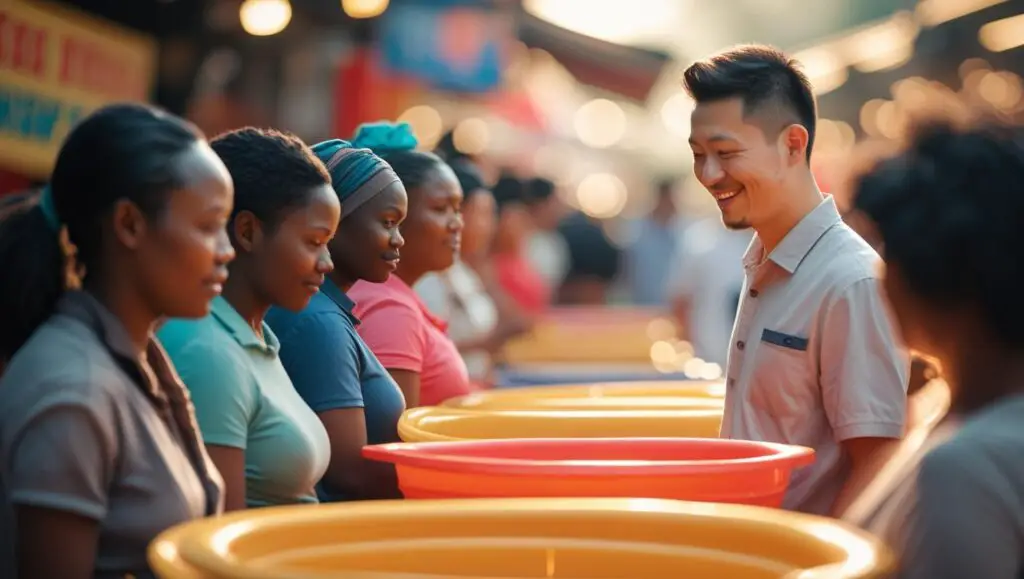In 2025, obtaining free large fish tubs has become increasingly achievable thanks to sustainability initiatives, recycling programs, aquaponics trends, and outreach from agricultural, aquaculture, and food industries. Whether you’re a homesteader, urban gardener, fish farmer, or DIY enthusiast, acquiring these valuable containers without spending a dime is possible—with the right approach.
Why Large Fish Tubs Are in High Demand
Large fish tubs, also known as aquaponic or aquaculture tanks, are versatile containers used for:
- Raising fish in backyard or commercial aquaponics systems
- Water storage for agriculture
- DIY hydroponics setups
- Rainwater harvesting
- Worm farming and composting
- Garden ponds and planters
With the increasing interest in sustainable living and urban farming, the demand for durable, spacious containers has surged.

Where to Get Free Large Fish Tubs in 2025
1. Local Restaurants and Seafood Suppliers
Restaurants and seafood processors often receive fish and shellfish in large food-grade containers. These plastic or fiberglass tubs are frequently discarded after use. Here’s how to get them:
- Visit in person: Go to seafood markets, sushi restaurants, and fish wholesalers. Ask politely if they discard their fish containers.
- Offer to pick up: Many are happy to have someone haul these away.
- Build relationships: Regular pickups could turn into a steady source.
2. Agricultural Supply Stores and Co-ops
Agricultural co-ops often receive large tubs or drums used for feed, fertilizers, or water storage. While not always marketed as “fish tubs,” these containers are ideal:
- Check for damaged or unsellable stock they might give away.
- Attend surplus sales where they liquidate old equipment.
- Look for local farming groups on Facebook or Craigslist that might be giving them away.
3. Aquaculture Facilities and Fisheries
Reach out to local hatcheries, fisheries, or university aquaculture departments. These places regularly rotate equipment and may have:
- Retired tanks or tubs that are still perfectly usable
- Research containers no longer needed
- Demo or testing units they’re willing to part with
Send a formal inquiry via email or drop by in person with a specific request.
4. Construction and Industrial Sites
Construction and industrial businesses often use heavy-duty plastic or metal tubs for site use, and they are discarded after certain jobs:
- Contact demolition or renovation crews—they might remove old fish tubs from restaurants or food factories.
- Reach out to commercial builders who may have them from HVAC or fluid systems.
Be sure to ask for containers labeled food-safe, especially if you plan to use them for fish or edible plants.
5. Online Marketplaces and Freecycling Platforms
The digital world is rich with free resources if you know where to look:
- Facebook Marketplace – Use keywords like “free fish tank,” “free tub,” “IBC tote,” or “aquaponics tank.”
- Craigslist – Check the “free” section under “For Sale.”
- Freecycle.org – Join your local group and post a “Wanted” ad for fish tubs.
- Nextdoor – A neighborhood platform perfect for finding free local supplies.
Set alerts for keywords and check daily to act fast when listings appear.
What to Look for in a Free Large Fish Tub
Not all containers are suitable for fish or garden use. Ensure the tubs you collect meet these criteria:
Material Type
- HDPE (High-Density Polyethylene) or polypropylene is best for food safety.
- Avoid PVC or anything that once held chemicals unless you can verify it’s safe.
Previous Use
- Fish-safe containers should not have held toxic substances, oil, or paint.
- Containers previously used for food storage or aquatic environments are ideal.
Size
- Look for tubs with a minimum of 50 gallons for fish.
- 100–300 gallons is excellent for larger operations or water reservoirs.
Structural Integrity
- No cracks, sharp edges, or significant warping.
- Drainage ports or the ability to add them is a bonus.
How to Clean and Prepare Free Fish Tubs
Even if a tub is labeled food-grade, proper cleaning is vital before use:
- Rinse thoroughly with a hose to remove dirt and residue.
- Scrub with a mixture of white vinegar and water (avoid bleach if using for aquaponics).
- Rinse multiple times until water runs clear and there’s no smell.
- Let air dry in the sun to help naturally disinfect the surface.
If tubs come with labels or chemical markings, check online databases for safety codes (look for recycling codes like #2 HDPE).
Creative Uses for Free Large Fish Tubs
Beyond fishkeeping, these containers serve many purposes:
- Aquaponics systems with tilapia, koi, or catfish
- Rainwater collection barrels with installed spigots
- Raised garden beds for deep-rooted crops
- Composting bins or worm farms
- Storage for animal feed or emergency water
Paint or wrap them with vinyl for aesthetic appeal in a backyard setup.
Join Communities That Share Free Aquaponic Resources
Becoming part of a network increases your chances of scoring free fish tubs and gear. Join:
- Aquaponics groups on Reddit and Facebook
- Local gardening clubs or permaculture meetups
- Urban farming cooperatives
These communities often host swaps, giveaways, or bulk ordering programs that include free containers.

Grants and Environmental Programs Offering Free Tubs in 2025
In 2025, many cities and nonprofits offer green living incentives. Some programs provide equipment grants or giveaways for sustainable projects:
- Check municipal sustainability departments for offers.
- Apply for small agriculture or water conservation grants that include infrastructure.
- Partner with schools or youth programs that may share access to community gear.
Many of these programs dispose of their old gear after each cycle—a goldmine of free tubs.
Repurpose IBC Totes and Drums
Intermediate Bulk Containers (IBCs) are used worldwide for transporting liquids and are often discarded after one use. Many are ideal as fish tubs after cleaning:
- Look for 275-330 gallon IBC totes.
- Cut them in half to make two tubs.
- Add plumbing fittings for drains or filters.
Many farms and factories give these away to avoid disposal fees.
Conclusion: Tap Into the Free Resource Goldmine
Free large fish tubs in 2025 are within reach if you’re resourceful, persistent, and connected. Use both digital platforms and local relationships to find discarded but valuable containers. With proper cleaning and creativity, these tubs can form the foundation of a thriving aquaponics system, sustainable garden, or innovative DIY project.


Leave a Reply